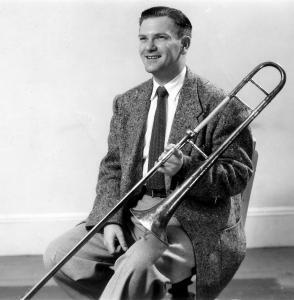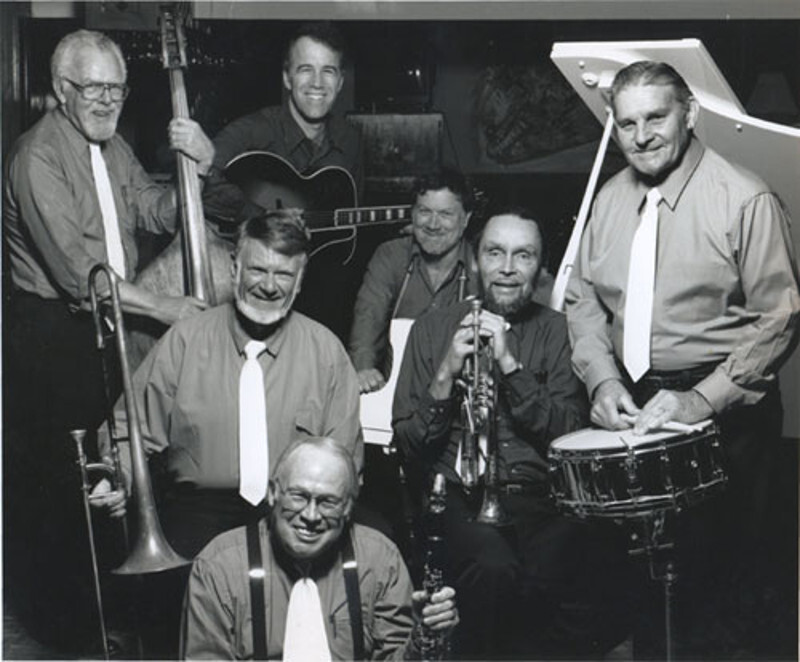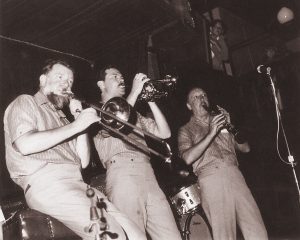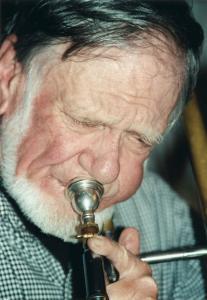
Bob Mielke, a very great jazz artist, a hero on trombone and a dear friend, has just died at 93. For me, Bob defined a special place and time for so long that it seems impossible he could be gone. I am thinking here of Berkeley, especially, and Oakland and the whole East Bay culture and jazz scene that went back to the 1940s and that I was lucky to be part of from the 1960s to the 1990s. Mielke was always there, soulful and deep, always part of any little house party or session, as well as a leader in some of the most creative “traditional” jazz gigs, concerts, festivals, and recordings.
For a long time you could zig-zag across town and find Bob, or Dick Oxtot with his banjo, or Walt Yost or Earl Scheelar on several instruments, or P. T. Stanton on guitar or trumpet, or Jim Goodwin on piano or cornet, or Barbara Dane, or Barbara Lashley or Bill Erickson, and many others nearby. Berkeley was alive with good jazz, sometimes at a moment’s notice. Bob Mielke and the wonderful Bill Bardin were always the trombone players.
I remember I first heard Mielke on record about Christmas time 1961. A trumpet playing friend Bob Cooke had an LP of blues by Barbara Dane accompanied by a true all star cast of Don Ewell, piano; Pops Foster, bass; P.T. Stanton, trumpet; Darnell Howard, clarinet; Bob Mielke, trombone. The music was full of passion and individual voices with skill, good taste and a sense of clear, open space between the horns.
Mielke was wonderful and although I didn’t fully understand it at the time, I can say now that he played with a lip vibrato and a lovely fluttery tone, especially when he lipped notes up and down with a sort of soft, popping sound. He had a sound like a human voice. I also heard the dark tones with his plunger mute and how he used a Harmon mute with the stem removed. It had a mournful, far away sound that I can never forget.
In 1963 on one of my early jazz visits to Berkeley I was fortunate to be part of a jazz party upstairs over Earl Scheelar’s Auto Service where Mielke, Barbara Dane, Dick Oxtot (my first connection to the bay area) and Earl Scheelar were playing, and I got to sit in. From that time on I loved the Berkeley scene and felt lucky to observe, learn and participate in much of Mielke’s future music.
Several times in the late 1960’s I got to hear a revival of Mielke’s original Bearcats band from the 1950s with P.T. Stanton, trumpet; Bunky Colman, clarinet; Pete Allen, bass; Oxtot, banjo and Don Marchant or Bill Dart on drums. It was a deep and original sound, sort of like New Orleans music mixed with Duke Ellington. There was a rich sense of melodic and harmonic continuity. They played freely but with arranged passages that Mielke called “spaghetti strips” of written music. The other musicians have been dead for years and now that living history is over.
I remember in the summer of 1964 playing piano at LaVal’s in Berkeley with Mielke and other good musicians like Ellis Horne on clarinet and Don Marchant on drums. I felt very much at home. And comfortable with Mielke. He was always a great “part player” with other horns but also an experimental and lyric creator in small or unusual combinations. In fact, during my years at the Bull Valley Inn in Port Costa during the 1970s, Bob would often be my horn on a two person job, not the usual path for a trombone. He loved playing melody with a big, beautiful sound, the sound of blues was in everything he played and he could play harmony with a piano solo.

Through the 1970s, ’80s and into the ’90s Mielke often played in various combinations with Dick Oxtot and in Ev Farey’s Golden State band, Bob Neighbor’s Sunday band at Earthquake McGoons, with his own New Bearcats band and my own Berkeley Rhythm. I was happy to be a part of all that. Wonderful musicians like Mielke’s long time friends Bill Napier, Richard Hadlock, and Jack Minger were regularly a part of all this. Of course, Mielke also directed the Oakland A’s band for many years. And I was lucky to sub for him on trombone when he had other gigs.
Starting in the 1940s Mielke had a remarkable career with a stunning combination of major players. Mielke recorded and worked with Bunk Johnson, Sidney Bechet, George Lewis, Lu Watters and Bob Wilber. Some of those musicians had styles that were quite different from each other, yet Mielke was able to fit in with all of them. How was that possible?
First of all, Mielke’s style brought together a wide range of influences. One of his early heroes was Geechy Fields, a New Orleans style trombonist with an uncluttered blues approach. He also absorbed the harmonic part playing of George Brunies and was influenced by the sound of swing players like Benny Morton and Claude Jones. He believed in beautiful tone production and he could shift from one style to another and it was always his true self. Mielke listened to the other horns, filled gaps and allowed open spaces among horns.

Traditional jazz is often seen as music with three horns: trumpet, trombone and clarinet. That isn’t quite true, but it is often the case. And in the hands of musicians who simply play without a sense of order, it can turn into a kind of mush, a Dixieland blur of sound where individual horns get lost in the overall sound. That never happened when Mielke played and I think of several good illustrations. Among the many bands that Ted Shafer assembled, the most exciting by far for me was the band with Ray Ronnei on trumpet, Bob Helm on clarinet, and Mielke on trombone. They were three very different players and their sound could have clashed, but they didn’t. Their recording together highlights each horn at all times, even during ensemble.
The same quality emerged in Mielke’s Bearcats. P.T. Stanton played some fast flourishes on trumpet, followed by stark open spaces. He relied on Bunky Colman’s clarinet to fill a big solo space. Then Mielke responded somewhere in between with a mix of part playing, and New Orleans and swing styles all at once. Also, in a memorable national public broadcast with Muggsy Spanier and Darnell Howard as frontline partners, the same thing happened. No Dixieland mush. Everyone was in the right place and Mielke was brilliant in ensemble and solo. He knew where to be in relation to the others.
Most jazz musicians have to wear suits or even a tuxedo from time to time. Mielke did, of course, but that is not the way I picture him. I see him in his old fashioned cap, khaki pants with suspenders, hiking boots, and a stage defined by a line of mutes and a canteen. He was a Berkeley guy, a liberal thinker, dedicated to truth and beauty in the arts. No show business. He had plenty of self doubts about his playing but he was always in the right place, even when he didn’t trust himself.

Mielke had a reputation for being grumpy and sometimes intimidating to other musicians. I never had that experience. He was quick to laugh and always fun to play music with. In 1969 when my family moved to Berkeley, Mielke was just moving out of his house on Benvenue. He passed it on to us. Before he lived there, our friend Dick Oxtot lived there and before that, Bob rented a room there in the 1940’s. I guess that’s the tribal part of Berkeley jazz, the part I remember most, and with Mielke always in the center of it.
(In December 2005 I wrote a long, feature story with full biography on Mielke for the Mississippi Rag magazine. In 2008 Jim Goggin published a book called Bob Mielke—A Life in Jazz. And they both bring detail to Bob’s long and creative story.)
Ray Skjelbred, pianist and leader of Ray Skjelbred and his Cubs, says, “I have generally thought of myself as an English teacher first, then pianist and poet.” Visit him online at rayskjelbred.com.






















